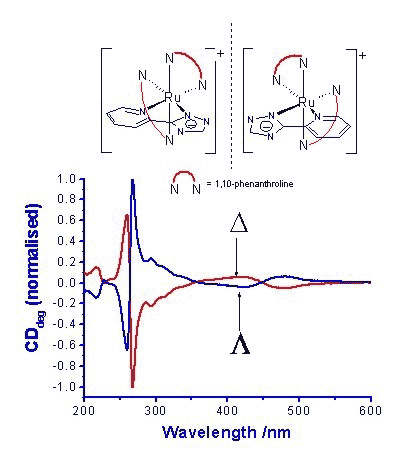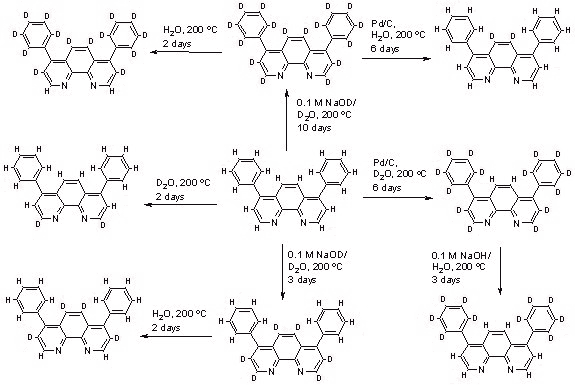Electron and energy transfer processes have become
increasingly important in the last half-century with the bottom-up focus in research areas such as supramolecular chemistry, nano-technology, biomimetics, artificial photosynthesis and photovoltaics. Understanding these transfer processes requires detailed study of both intra- and intermolecular communication and, in our case, the interaction of light with transition metal-based compounds. At the Inorganic Chemistry Laboratory in DCU, we are primarily concerned with understanding intramolecular interactions in polypyridyl complexes. This research covers a diverse range of areas, including intercomponent processes in transition metal-based multi-centred systems, stereochemistry and isotopic labelling reactions. The overall aim of these studies is to develop a greater understanding of how communication between components in nano-assemblies might be controlled.
 Circular Dichroism spectra of the two enantiomers of a Ruthenium based system separated by chiral High Pressure Liquid Chromatography. Chirality (handedness) is a very important property in biological systems and its influence on the properties of transition metal based systems is of interest.
The immediate environment and stereochemistry in molecular aggregates is of immense importance to the functioning of biological molecular assemblies. As a result, considerable attention has been directed towards developing an understanding of how chirality and the solvent environment affect the properties of the systems we are investigating at DCU (in collaboration with researchers at Osaka University and the University of Rome). Of primary concern was the effect of chirality on the properties of one and two centred inorganic systems, in chiral and non-chiral environments.
Circular Dichroism spectra of the two enantiomers of a Ruthenium based system separated by chiral High Pressure Liquid Chromatography. Chirality (handedness) is a very important property in biological systems and its influence on the properties of transition metal based systems is of interest.
The immediate environment and stereochemistry in molecular aggregates is of immense importance to the functioning of biological molecular assemblies. As a result, considerable attention has been directed towards developing an understanding of how chirality and the solvent environment affect the properties of the systems we are investigating at DCU (in collaboration with researchers at Osaka University and the University of Rome). Of primary concern was the effect of chirality on the properties of one and two centred inorganic systems, in chiral and non-chiral environments.
The control of communication between active molecular centres is also of interest at DCU. In collaboration with researchers in the University of Messina and the University of Bologna, we are working towards the development of 'bridges', which allow for external control of the level and type of communication between molecular units. The ability to allow for strong but tuneable levels of intramolecular communication over relatively large distances in a predictable manner, by variation of the spacer groups involved, is a significant advance in the future development of molecular based Photonic systems.
 Synthetic routes for the preparation of a range of regioselectively deuteriated 4,7-diphenyl-1,10-phenanthrolines
In conjunction with the study of metal-based systems, the use of isotopic
labelling (e.g. replacing hydrogen {�H} with its �heavier alter-ego
deuterium {�H}) as a spectroscopic tool is of particular interest to DCU researchers. The novel procedures we have recently developed to produce isotopically labelled materials in useable quantities has enabled us to probe much deeper into the fundamental processes involved in the absorption of light energy by transition-metal based systems and the transfer of that energy between components within these systems. The processes involved are extremely fast and require the use of techniques such as resonance Raman and luminescence spectroscopy which are capable of observing events which occur in less than a picosecond (a million millionth of a second) to a few microseconds (a millionth of a second). The use of isotopic labelling in these spectroscopic studies has enabled the strengthening of existing collaborative links with researchers at the University of Bologna, Queen's University Belfast and Trinity College Dublin, and has resulted directly in the creation of new links with researchers in The Netherlands, Hungary, Germany, New Zealand and the United States.
Synthetic routes for the preparation of a range of regioselectively deuteriated 4,7-diphenyl-1,10-phenanthrolines
In conjunction with the study of metal-based systems, the use of isotopic
labelling (e.g. replacing hydrogen {�H} with its �heavier alter-ego
deuterium {�H}) as a spectroscopic tool is of particular interest to DCU researchers. The novel procedures we have recently developed to produce isotopically labelled materials in useable quantities has enabled us to probe much deeper into the fundamental processes involved in the absorption of light energy by transition-metal based systems and the transfer of that energy between components within these systems. The processes involved are extremely fast and require the use of techniques such as resonance Raman and luminescence spectroscopy which are capable of observing events which occur in less than a picosecond (a million millionth of a second) to a few microseconds (a millionth of a second). The use of isotopic labelling in these spectroscopic studies has enabled the strengthening of existing collaborative links with researchers at the University of Bologna, Queen's University Belfast and Trinity College Dublin, and has resulted directly in the creation of new links with researchers in The Netherlands, Hungary, Germany, New Zealand and the United States.
*
Dr Wesley R. Browne was the recipient of the 2002 Royal Irish Academy Prize for Young Chemists sponsored by AGB Scientific and
The Irish Times.
The content of this article is a summary of the work on which his PhD thesis was based.
Contact: Dr Wesley Browne, School of Chemical Sciences, DCU, Dublin 9;
E-mail:
[email protected]
|


